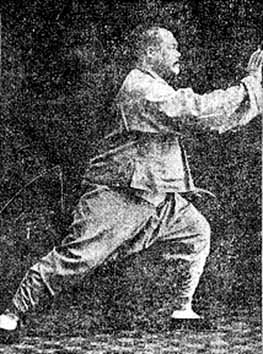
The Third Rep: 2000-07-01
by Jerry Karin
In Yang Zhenduo’s book, Zhongguo Yang Shih Taiji, 1997, for each move there is a section called “Important Points”. The important points are combined for left and right ward off. Points three and four of this group are particularly eloquent, and we include a translation of them here.
3. When you make a bow step, as the weight shifts from one foot to the other, you should pay attention to the symmetrical arrangement of the two opposing forces – one leg pushing and the other pushing back or resisting. Whether the front leg is pushing backward and the back leg resisting, or the back leg is pushing forward and the front leg resisting, the forces must be coordinated, so as to avoid pushing out too hard or resisting too hard, or pushing out emptily without any compensating resistance. The waist, if firmly in command, can propel the four limbs, cause the upper and lower body to work in concert, and better complete every move and posture. But if you fail to control the lower limbs and they do not match what is going on in the rest of the body, although the waist has the capability of commanding the four limbs, it’s no use. K So in the Tai Chi world when we particularly emphasize utilizing a whole-body movement, that is actually this matching of opposed forces, the mutually restricting coordination of the entire body. As people often say, ‘Tai Chi is a whole body exercise’ and is different from activities which involve moving sections or parts of the body only. I hope you will work hard to incorporate this point in your form.
4. Here’s how to step into the bow step: Whenever the foot which is stepping out descends to the floor, first touch the heel to the floor, next the toes grab the floor, and then finally, the knee bends and moves forward. During the entire process, as the weighted leg pushes forward and the empty leg resists, one sending and one receiving force, (especially in the case of of the resisting, empty leg) you must never stop pushing or resisting but you must also not push or resist too forcefully. If you stop one of the opposing forces then you will lose your balance and if you use too much force then you’ll be stiff; neither of these is good. If you can achieve just the right balance in this, it will create favorable conditions for upper and lower body to work in concert during transitional moves. When extending the weighted (back) leg to its ultimate position in a bow step, just as in the extension of an arm, extend until it is almost fully extended but not quite. If you over-extend then it becomes forced and looks stiff. If the back leg is bent too much, the pushing force cannot come out, and it will seem as if you have a lot of power but can’t use it. The resistance of the empty leg goes through a process of gradual engagement. First touch the floor with the heel, continue by allowing the flat of the foot to touch, then the toes grab the floor, and then let the knee bend forward, letting the bending knee and shin slightly incline forward and increasing the resistance from the front leg so as not to allow the knee to pass the toe. This way, with one leg pushing and one leg resisting, neither force subsiding or becoming too strong, the lower body will become a great deal stronger and more stable. Note that if the knee and shin of the forward leg are standing perpendicular to the ground then it is hard to utilize the resisting force and the back leg won’t be able to develop power in its push forward. If the knee goes past the toe, you’ll lose your balance and the back leg again won’t be able to develop much power Only when you make the knee and shin slightly incline forward, with the knee not going past the toe, can you thoroughly get the full strength of the two forces, pushing out and resisting, to come into play.
